It was a busy year for patent litigation across the broad, including the U.S. Patent and Trademark Office Patent Trial and Appeals Board (PTAB), U.S. District Courts (USDC), Court of Appeals for the Federal Circuit (CAFC), and the Supreme Court of the United States (SCOTUS). A quick look at the number of patent litigation cases filed over the years, particularly the last five years, show that while there has been a decrease in the number of cases filed with the USDC, the filings with the PTAB and CAFC saw a significant increase.
Total Number of Patent Litigation Cases 2008 to 2017

USDC patent case counts include cases addressing the infringement, validity, or enforceability of a U.S. patent that are pending in a U.S. district court or the Court of Federal Claims. This encompasses cases flagged with Nature of Suit ("NOS") 830 in the PACER system as well as other cases that are known to meet the above criteria. Transferred, consolidated, coordinated, or bifurcated actions may contribute to the number of cases counted.
PTAB cases include applications to the PTAB for inter partes reviews and post-grant reviews pursuant to 35 U.S.C. § 6(a)(4), as reported in the PTAB's Patent Review Processing System ("PRPS"). The term does not include proceedings conducted pursuant to 35 U.S.C. § 6(a)(1)-(3) such as appeals of adverse decisions of examiners, appeals of reexaminations, or derivation proceedings. Data obtained from Docket Navigator analytics.
SCOTUS was called upon to make important decisions ranging from patent venue laws, patent exhaustion to a U.S. manufacturer's liability for exporting components later incorporated into an infringing product, including amendments during inter partes review. The year started with predictions as to whether the Supreme Court will consider the issue of whether IPR violates the U.S. Constitution by extinguishing private property rights through a non-Article III forum without a jury, in Oil States Energy Services LLC v. Greene's Energy Group, LLC, and ended with predictions regarding the outcome of the oral arguments heard by the Court in November. Although faced with the issue before, the fact that Supreme Court decided to hear the issue now is not surprising given the increasing number of IPRs being filed with the PTAB and a slow decrease in the number of IPR petitions being instituted (coupled with increase in the number of IPR petitions being denied).
Institution Rates from FY13 to FY18 (Source: PTAB)
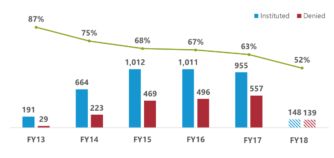
The number of post-grant proceedings filed in the technologies related to Electrical/Computer & Mechanical are much higher than those filed in the Bio/Pharma and Chemical technology areas. However, the rate at which the petitions are instituted is similar in each of the technology areas.
Institution Rates by Technology 09/16/2012 to 11/30/2017(Source: PTAB)
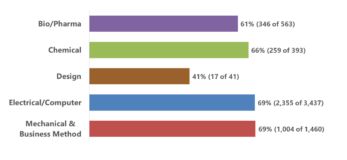
Also, the post- and pre-institution settlement rates have remained the same for the last two years, which are noticeably lower as compared to two years prior to that and significantly lower (at least for post-settlements) compared to five years ago. Although it may be tempting to associate this decrease in settlements to the predictions of Oil States' challenge for the constitutionality of IPR proceedings, it would not be appropriate to do so given that the issue has been discussed previously.
Pre-Institution Settlements (Source: PTAB)

Post-Institution Settlements (Source: PTAB)
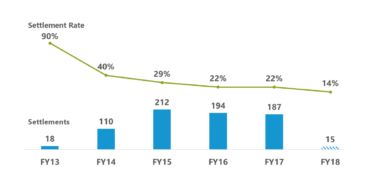
The Supreme Court's decision in Oil States could have a major impact on the patent world, and is clearly the center of attention as the new year begins. Certainly, the decision in TC Heartland has proved to be a game-changer in patent filings. According to a recently published report by Fried, Frank, Harris, Shriver & Jacobson LLP, a substantial difference was noticed in the patent infringement filings from May 2017 to September 2017 when compared to the same period in 2016 in at least two of the top ten District Courts. The patent filings in the Eastern District of Texas, which is considered a plaintiff-friendly jurisdiction, decreased from 39.61% in 2016 to 15.04% in 2017; while the district of Delaware saw a rise in the filings, which is not surprising given most companies are either based out of, or majorly operate, in Delaware.
Top 10 District Courts: Pre- and Post-TC Heartland
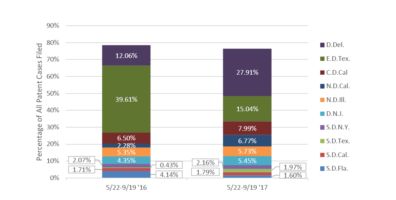
It is not unusual that a decision, even by the Supreme Court, sometimes tends to pose more questions than it answers. The decision in Life Technologies Corp v. Promega Corp. is certainly amongst the top in 2017, wherein the Supreme Court had to address the issue of a U.S. manufacturer's liability for exporting components later incorporated into an infringing product. While addressing a specific dispute pertaining to diagnostic kits between the parties, the Court raised many questions without providing any guidance as to the answers for those questions. The court held that the term "substantial portion" in Section 271(f)(1) has a quantitative, not a qualitative, meaning. More specifically, the court held that the phrase "substantial portion" in the statute does not cover the supply of a single component of a multicomponent invention. One of the obvious questions this decision raises is what if the invention is a two-component invention?" Would the supply of a single component of a two components invention still be outside the scope of the statute? Given the continuing growth in international commerce, it is fair to predict that the Courts might have to address this issue sooner than later.
This year was also marked by the Supreme Court deciding on its first case related to Biologics Price Competition and Innovation Act ("BPCIA"). The Court was called upon to review an issue regarding the notice requirements of BPCIA. Although, the Court provided clear guidance that biosimilar applicants may provide 180-day notice of commercial marketing prior to the FDA's approval of the application, it left some questions for the CAFC to decide. The Court held that the Federal law does not provide for an injunction requiring a biosimilar applicant to start the patent dance by providing its application and manufacturing information to the reference product's sponsor under 42 U.S.C. § 262(l)(2)(A) and remanded the case to CAFC for further proceedings. In December, the CAFC held that BPCIA preempts any state law remedies for failure to comply with § 262(l)(2)(A) and concluded that applying state law would create a conflict with the careful balance struck by Congress in establishing the BPCIA.
The CAFC also had its share (65% of its docket) of intellectual property law cases, including 29% resulting from appeals from the District Court decisions and 33% resulting from appeals from the PTAB.
Appeals Filed, by Category for FY 2017 (Source: CAFC)

A review of filings over the last 10 years reveals that the number of appeals filed with the Federal Circuit resulting from the PTAB have risen significantly in the last 4 years.
Appeals Filed, by Category for FY 2006 to FY 2017 (Source: CAFC)
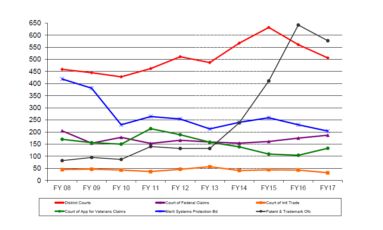
This increase in the appeals resulting from PTAB is consistent with the number of petitions for post-grant proceedings filed with the PTAB. It will be interesting to see how the trend, particularly in inter-partes review filings, will change once the Supreme Court issues its final written decision.
The content of this article is intended to provide a general guide to the subject matter. Specialist advice should be sought about your specific circumstances.

